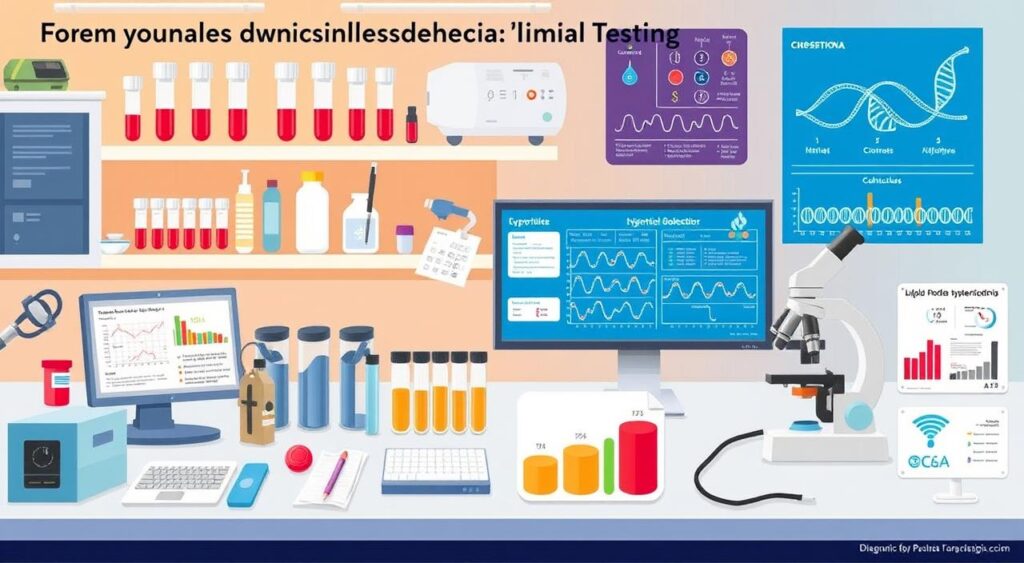Familial Combined Hyperlipidemia: A comprehensive guide to understanding this genetic disorder, including its causes, symptoms, and effective treatment options.
Familial combined hyperlipidemia: It’s a genetic disorder that causes high cholesterol and triglycerides. This condition greatly increases the risk of heart disease. It’s vital to know about familial combined hyperlipidemia and how it affects health.
Since it’s a genetic disorder, managing it needs a detailed plan. This includes understanding the condition and finding the right treatment.

Key Takeaways
- Familial combined hyperlipidemia is a genetic lipid disorder that affects 1 in 100 people in the US.
- It can lead to high levels of cholesterol and triglycerides in the blood, increasing the risk of cardiovascular disease.
- Understanding the genetic basis of familial combined hyperlipidemia is crucial for developing effective treatment and management strategies.
- Familial combined hyperlipidemia requires a comprehensive approach to management and treatment.
- Early diagnosis and intervention can help mitigate the risks associated with this condition.
- Lifestyle modifications, such as dietary changes and exercise, can play a crucial role in managing familial combined hyperlipidemia.
Understanding Familial Combined Hyperlipidemia
Familial combined hyperlipidemia is a complex condition. It is marked by high cholesterol and abnormal lipid metabolism. It’s often linked to familial hypercholesterolemia, a genetic disorder that messes with cholesterol regulation. Knowing about this condition is key to understanding its health impact.
About 1 in 100 people are affected by familial combined hyperlipidemia. It significantly raises the risk of heart disease and other health issues. Lipid metabolism disorders can cause artery plaque buildup, leading to heart attacks and strokes.
Definition and Overview
Familial combined hyperlipidemia is a genetic disorder. It messes with lipid metabolism. It’s marked by high LDL cholesterol and triglycerides, and low HDL cholesterol.
Prevalence and Demographics
It’s more common in those with a family history of high cholesterol or heart disease. It affects people of all ages, but risk grows with age.
Impact on Health
Familial combined hyperlipidemia can severely impact health. It raises the risk of heart disease and other issues. Understanding this condition and its effects on lipid metabolism is crucial for effective management.
Early diagnosis and treatment are vital for managing familial combined hyperlipidemia. By grasping the condition and its health effects, individuals can lower their risk of complications and enhance their health.
| Condition | Description |
|---|---|
| Familial Hypercholesterolemia | A genetic disorder that affects the body’s ability to regulate cholesterol levels |
| Familial Combined Hyperlipidemia | A condition characterized by high cholesterol and abnormal lipid metabolism |
The Genetic Basis of FCH
Familial Combined Hyperlipidemia is a complex genetic lipid disorder. It involves many genes that affect how our body handles lipids. This condition leads to inherited high cholesterol, raising the risk of heart disease. Knowing the genetic roots of FCH is key for early detection and treatment.
Studies reveal that FCH comes from a mix of genes and environment. The genes we get from our parents play a big role, making it an inherited high cholesterol issue. The genes involved affect how our body makes and moves cholesterol and triglycerides.
- Genetic mutations that affect lipid metabolism
- Family history of high cholesterol or heart disease
- Environmental factors, like diet and lifestyle
Knowing how FCH is caused helps people manage it better. They can change their lifestyle, eat right, and exercise. Regular genetic tests and counseling are also important. If you have a family history of genetic lipid disorder or inherited high cholesterol, talk to your doctor. They can help you understand your risk and create a plan to stay healthy.
How FCH Affects Lipid Metabolism
Familial Combined Hyperlipidemia (FCH) greatly impacts how our body handles fats. It leads to higher levels of cholesterol and triglycerides in the blood. This raises the risk of heart disease. It’s key to understand how FCH affects fat handling to find good treatments.
People with FCH often see changes in how their body handles fats. This results in high cholesterol levels. The condition messes with how the body makes and breaks down fats, including cholesterol and triglycerides. This makes it more likely for them to get heart disease.
Cholesterol Production
Cholesterol making is a big part of fat handling. In FCH, the liver makes too much cholesterol. This can cause high cholesterol in the blood. High cholesterol can lead to plaque buildup in arteries, raising heart disease risk.
Triglyceride Metabolism
Triglyceride handling is also changed in FCH. Triglycerides are fats in the blood, and high levels are bad for the heart. FCH can mess up how the body breaks down triglycerides, leading to too much of them.
Lipoprotein Abnormalities
Lipoproteins play a big role in fat transport in the blood. In FCH, lipoproteins don’t work right. This can cause too much of the “bad” LDL cholesterol.
To manage FCH and lower heart disease risk, we need to tackle fat handling and cholesterol. This can be done through lifestyle changes and medical treatments.
| Lipid Metabolism Aspect | Effect of FCH |
|---|---|
| Cholesterol Production | Increased production |
| Triglyceride Metabolism | Impaired metabolism |
| Lipoprotein Abnormalities | Increased LDL cholesterol |
Common Signs and Symptoms
Familial combined hyperlipidemia often doesn’t show symptoms early on. But, there are signs that can hint at its presence. Regular health checks are key for catching it early. This can stop the disease from getting worse and lower heart disease risks. Symptoms include high cholesterol and triglycerides in the blood.
Some common signs and symptoms of familial combined hyperlipidemia include:
- High levels of low-density lipoprotein (LDL) cholesterol
- High levels of triglycerides
- Low levels of high-density lipoprotein (HDL) cholesterol
- Xanthomas, which are fatty growths on the skin
- Xanthelasma, which are yellowish patches on the skin around the eyes
Knowing these symptoms is crucial. If you notice them, see a doctor right away. Early treatment can greatly reduce heart disease risks.
Understanding familial combined hyperlipidemia’s signs helps manage it. Making healthy lifestyle choices and working with a doctor are important steps. This includes eating well and exercising regularly.
Risk Factors and Complications
People with Familial Combined Hyperlipidemia face a higher risk of cardiovascular disease. This is because they have inherited high cholesterol and lipid disorders. These conditions can cause lipids to build up in the blood, harming blood vessels and raising heart disease risk.
Other factors like age, family history, and health conditions also increase this risk. Knowing these factors is key to managing the condition well and avoiding serious problems. Some major risks and complications include:
- Increased risk of cardiovascular disease
- Development of lipid disorders, such as hypertriglyceridemia
- Pancreatitis, a condition characterized by inflammation of the pancreas
Age is another important factor in managing Familial Combined Hyperlipidemia. As people get older, their risk of cardiovascular disease grows. It’s crucial to keep an eye on and manage the condition as they age. By understanding the risks and complications, people can take steps to manage their condition and lower their risk of cardiovascular disease and other health issues.
| Risk Factor | Description |
|---|---|
| Family History | Individuals with a family history of cardiovascular disease or lipid disorders are at a higher risk of developing Familial Combined Hyperlipidemia |
| Age | The risk of cardiovascular disease increases with age, making it essential to monitor and manage the condition effectively |
Diagnostic Process and Testing
Diagnosing familial combined hyperlipidemia involves a few steps. First, a doctor will do a physical exam and ask about your medical history. This helps find any signs or risks linked to familial combined hyperlipidemia.
The next step is to run some tests. These include checking your lipid levels, like cholesterol and triglycerides. Doctors might also use genetic tests to confirm the diagnosis.

Here are some tests used to diagnose familial combined hyperlipidemia:
- Lipid profile tests
- Genetic testing
- Liver function tests
These tests help doctors diagnose and treat familial combined hyperlipidemia well.
A thorough diagnosis is key to creating a good treatment plan for familial combined hyperlipidemia.
Knowing about the diagnostic process and tests helps those with familial combined hyperlipidemia. They can work with their doctors to manage their condition and lower the risk of problems.
Treatment Options and Management Strategies
Managing Familial Combined Hyperlipidemia (FCH) needs a full plan. This includes different treatments to lower heart disease risk. It’s key to understand how lipid metabolism works to create a treatment plan that fits you.
For FCH, treatments often mix medicine and lifestyle changes. Statins can lower cholesterol, while diet and exercise help with lipid metabolism. It’s important to talk to a doctor to find the right treatment for you.
Managing FCH involves several steps:
- Medication adherence: Taking your medicine as told to keep lipid levels right.
- Lifestyle modifications: Eating well, exercising, and managing stress to boost health.
- Monitoring and follow-up: Regular doctor visits to check progress and adjust plans if needed.
By following a detailed treatment plan and making smart lifestyle choices, people with FCH can lower heart disease risk. It’s vital to work with a doctor to create a plan that meets your specific needs and goals.
With the right treatments and strategies, FCH can be well-managed. Focusing on lipid metabolism and health helps take control of the condition. This approach improves overall well-being.
| Treatment Option | Description |
|---|---|
| Medication | Statins, bile acid sequestrants, and other medications to lower cholesterol levels. |
| Lifestyle Modifications | Dietary changes, exercise, and stress management to improve lipid metabolism and overall health. |
| Monitoring and Follow-up | Regular check-ups with a healthcare provider to track progress and adjust treatment plans. |
Lifestyle Modifications for FCH Management
Managing Familial Combined Hyperlipidemia (FCH) needs a full approach. A healthy lifestyle is key to lowering cholesterol and managing lipid disorders linked to FCH. Making smart choices in diet, exercise, and stress can help manage the condition and avoid serious issues.
Some important lifestyle changes for FCH include:
- Dietary changes: Eat a balanced diet with less saturated fats and more fiber, fruits, and veggies.
- Exercise recommendations: Regular physical activity, like walking or jogging, can lower cholesterol and boost health.
- Stress management: Use stress-reducing methods, like meditation or yoga, to handle stress and anxiety.
By adding these lifestyle changes to daily life, people with FCH can manage their condition better. It’s crucial to work with a healthcare provider to create a plan that fits individual needs and health status.
Choosing healthy lifestyle options can greatly improve overall health and well-being. By focusing on healthy habits and consulting with a healthcare provider, individuals with FCH can manage their condition and enhance their quality of life.
| Lifestyle Modification | Benefits for FCH Management |
|---|---|
| Dietary changes | Reduces high cholesterol and lipid disorders |
| Exercise recommendations | Improves overall health and lowers cholesterol levels |
| Stress management | Helps manage stress and anxiety |
Living with FCH: Daily Considerations
Living with Familial Combined Hyperlipidemia (FCH) means understanding the condition well. Effective management includes medication, lifestyle changes, and regular check-ups. People with FCH need to watch their diet, exercise, and stress levels closely.
Important things to think about when living with FCH are:
- Eating a healthy diet low in saturated fats and cholesterol
- Doing regular physical activity, like walking or jogging, to lower lipid levels
- Managing stress with techniques like meditation or deep breathing
- Checking lipid levels often and changing treatment plans if needed
By following these daily considerations, people with FCH can manage their condition well. It’s crucial to work with a healthcare provider to create a personalized treatment plan. This plan should include any necessary changes to daily considerations.

Living with FCH is a long-term commitment to healthy habits and regular monitoring. By focusing on daily considerations and working with a healthcare provider, people with FCH can live a high-quality life. They can also lower the risk of complications from the condition.
Prevention Strategies for Family Members
Family members of people with Familial Combined Hyperlipidemia face a higher risk of getting it too. To lower this risk, it’s key to use effective prevention methods. One important step is to get genetic testing to find genetic mutations that might lead to Familial Combined Hyperlipidemia or familial hypercholesterolemia.
Starting early is crucial in stopping or managing the condition. This can be done by making lifestyle changes and getting medical help. Family members can help themselves by eating healthy, exercising regularly, and checking their lipid levels often.
Key Prevention Strategies
- Genetic testing to identify potential genetic mutations
- Early intervention through lifestyle modifications and medical interventions
- Regular monitoring of lipid profiles
- Family planning to reduce the risk of passing on the condition to future generations
By using these prevention strategies, family members can lower their chance of getting Familial Combined Hyperlipidemia and familial hypercholesterolemia. It’s important to work with healthcare experts to make a plan that fits each person’s needs and risks.
With genetic testing, early action, and lifestyle changes, family members can take steps to prevent or manage Familial Combined Hyperlipidemia. This can help reduce the risk of other health problems too.
| Prevention Strategy | Description |
|---|---|
| Genetic Testing | Identify potential genetic mutations that contribute to Familial Combined Hyperlipidemia |
| Early Intervention | Implement lifestyle modifications and medical interventions to prevent or manage the condition |
| Family Planning | Reduce the risk of passing on the condition to future generations |
Latest Research and Future Treatments
Recent studies have greatly improved our understanding of Familial Combined Hyperlipidemia. This has opened doors for latest research and new future treatments. The focus on lipid metabolism has led to new ways to manage this condition.
Researchers are now looking into gene therapy and RNA interference. These methods aim to fix specific genetic issues linked to FCH. They are also exploring new ways to lower cholesterol and improve diets.
As new treatments emerge, it’s crucial for those with FCH and their doctors to keep up with the latest. This way, they can make the best choices for their care. They can use the latest knowledge on lipid metabolism to manage the condition effectively.
Some possible future treatments for FCH could be:
- Personalized medicine, tailored to each person’s genetic makeup
- New drugs that target specific parts of lipid metabolism
- Technologies like gene editing and stem cell therapy
Conclusion
This guide has given a detailed look at familial combined hyperlipidemia. It’s a complex genetic condition that raises cholesterol and triglycerides levels. Knowing the genetic cause, its effect on lipid metabolism, and risk factors helps manage it well.
It has covered how to diagnose, treat, and change lifestyle to lower heart disease risk. Early action, regular check-ups, and genetic tests for family members are key. These steps help prevent serious health issues.
As research grows, better ways to handle familial combined hyperlipidemia are on the horizon. By staying updated and managing the condition, people can control their health. This way, they can live a happy and healthy life.
FAQ
Q: What is Familial Combined Hyperlipidemia (FCH)?
A: Familial Combined Hyperlipidemia (FCH) is a genetic disorder. It affects how the body handles fats, leading to high cholesterol and triglycerides. This increases the risk of heart disease.
Q: Who is at risk of developing Familial Combined Hyperlipidemia?
A: FCH is inherited, passed from parents to children. People with a family history of high cholesterol or heart disease are more likely to get it.
Q: How does Familial Combined Hyperlipidemia affect lipid metabolism?
A: FCH disrupts both cholesterol and triglyceride metabolism. This causes an abnormal buildup of lipoproteins. This buildup can lead to heart disease.
Q: What are the common signs and symptoms of Familial Combined Hyperlipidemia?
A: Early stages of FCH may not show symptoms. Signs include high cholesterol and triglycerides, fatty skin deposits, and a family history of heart disease.
Q: How is Familial Combined Hyperlipidemia diagnosed?
A: Diagnosis involves a physical exam, medical history, and lab tests. Tests like lipid profiles and genetic testing help identify the condition and its severity.
Q: What are the treatment options for Familial Combined Hyperlipidemia?
A: Treatment includes medication like statins and lifestyle changes. A healthy diet, exercise, and stress management are key. Regular check-ups with healthcare providers are also important.
Q: How can family members of those with Familial Combined Hyperlipidemia be protected?
A: Family members can be protected through genetic testing and early intervention. Lifestyle changes and monitoring can also help prevent heart disease.
Q: What is the latest research and future treatments for Familial Combined Hyperlipidemia?
A: Research is ongoing to improve treatments for FCH. New genetic understanding, therapies, and technologies are being explored. Keeping up with research is important for both healthcare providers and patients.
